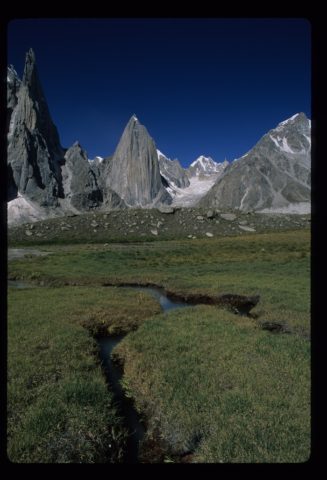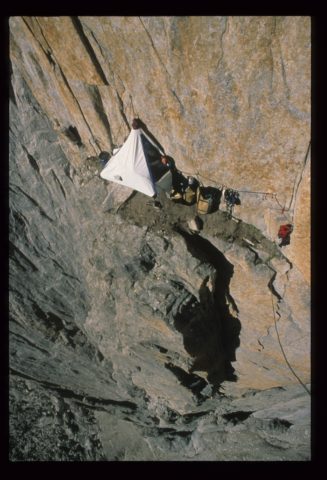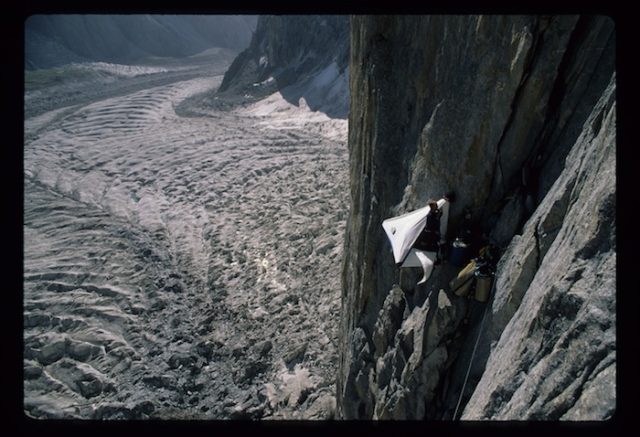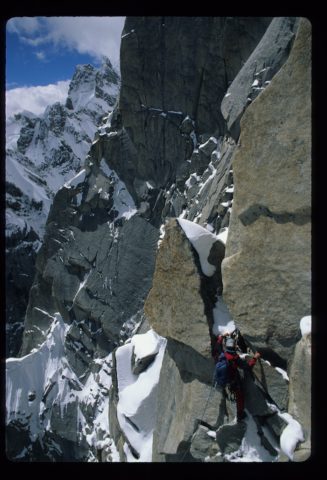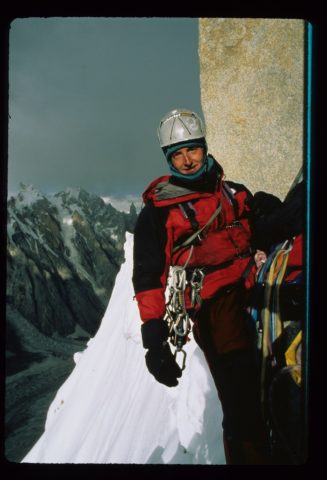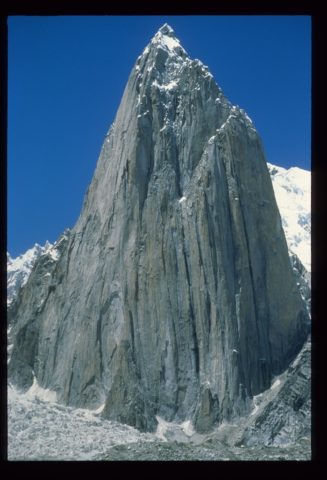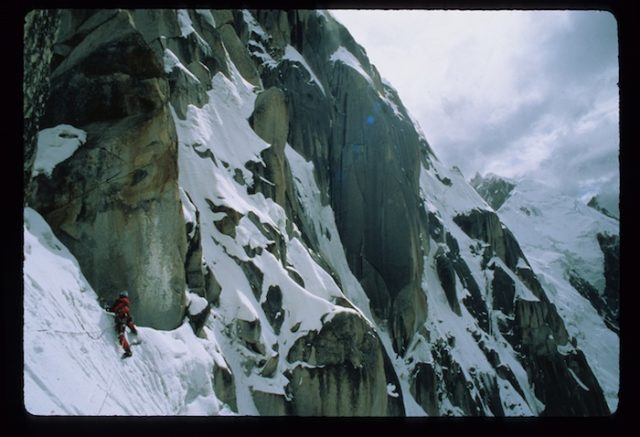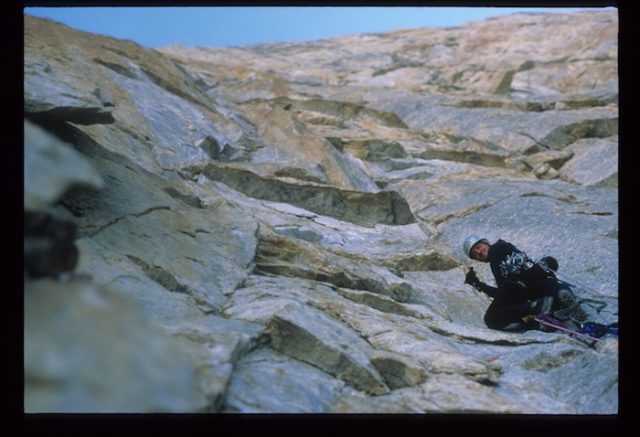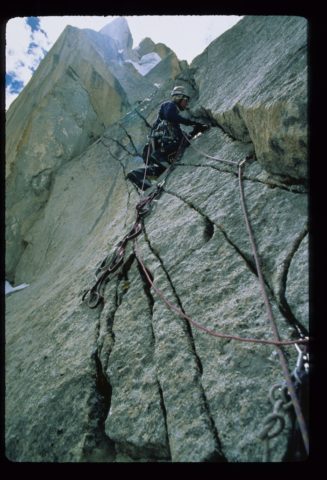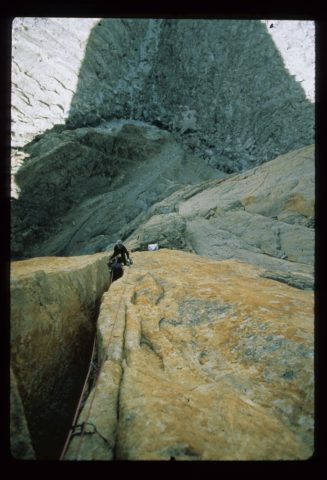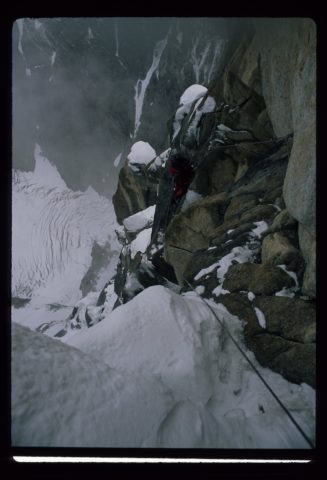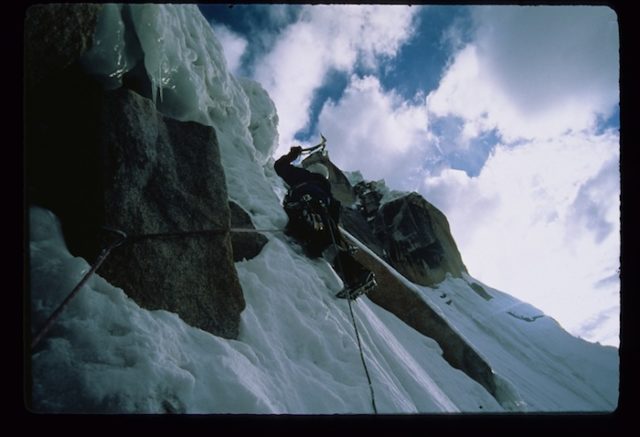1997 – Shipton Spire, Pakistan
Details
Team: Mark Synnott, Jared Ogden
When: June-August, 1997
Where: Trango and Hainablak Glaciers, Karakoram, Pakistan
Sponsor: The North Face
Explore Mark's other expeditions:
When I started climbing in the mid 1980s, nothing fueled my fire for adventure more than the rock spires lining Pakistan’s Baltoro Glacier. High-altitude, big wall climbing on granite fangs bigger than El Capitan – you just couldn’t go any sicker than that. I had no idea what was actually involved in such climbs, but secretly, I wondered if it might ever be possible for me.
When college came to an end, my parents were decidedly disapproving of my plans to take early retirement and move into a cave in Yosemite. I’m sure I could have pretended there was some type of work involved, but for some reason I had to make a point of being brutally honest about everything. My dad insisted I go to the campus career counseling center where they offered a bubble test that could magically predict your future vocation. I felt bad for the counselor, but I couldn’t help but laugh when he gave me the choices: park ranger, outdoor educator, landscape architect. The only thing that sounded remotely appealing was tree surgery (swinging around on ropes with chainsaws might not be bad).
Four years later, groveling in my cave above Camp Four was starting to get old, and I figured it was time to move on. I had paid some dues in the Valley, and after two trips to Baffin Island, I finally felt like I was ready to step up to the Karakoram. The obvious choice would be the Trango Towers, but I kept getting distracted by some dream-like pictures I’d seen of a 19,700 foot peak called Shipton Spire. Whereas Trango had by now been climbed dozens of times, Shipton had only seen its first ascent in 1996.
The mountain had remained in almost total obscurity because it lies hidden in a seldom visited side valley off the Trango Glacier. It was first discovered by climbers in 1989 when American Greg Collum initiated a search after finding a photo of the peak in Eric Shipton’s classic book, The Six Mountain Travels. On a hunch, Collum hiked past the Trango group along the same route Shipton followed on his trek through the Karakoram into China in 1938. Less than two hours hike from the populated Trango base camp, Collum found his prize. Shipton Spire, half again as big as Nameless Tower – and totally virgin – was now a tangible climbing objective.
Three years later, Collum was back in Pakistan with a strong team consisting of Andy Selters, Chuck Boyd and the late Mark Bebie. They came close to success on Shipton, turning back approximately 800 feet shy of the summit in the face of bad weather and dwindling rations. An article on this ascent, penned by Selters, appeared in Climbing Magazine in 1994; reading it, I soon realized that my Karakoram dreams now had a name and a face.
Other climbers were also waking up to the existence of this still virgin summit, and that group included a bold Japanese man named Ryuchi Taniguchi. In 1995 Ryuchi undertook a solo ascent on a similar line to that followed by the Americans in 1992. He put 2,000 feet between himself and the ground before he was brutally torn from the wall by the peak’s frequent rockfall. His body was recovered by Balti porters, but his haulbags still dangle 13 pitches up as a grim reminder of Shipton’s considerable objective hazard.
The next year, Collum was back to give Shipton one more go, together with his old teammate Chuck Boyd and new recruits Greg Child and Greg Foweraker. With previous knowledge of the wall they decided to stay away from the devious west ridge which had proved so problematic in 1992. Instead, they chose what is probably Shipton’s longest route, a bulging pillar in the center of the south face.
Collum actually bailed on the climb part way through, fed up by the constant danger and personality tensions amongst the group. The three others persevered, but were still thwarted within 30 feet of the summit by unconsolidated, dangerous snow conditions on the final cornice. After 36 pitches of climbing at the highest standard, the team deemed their effort to be close enough and claimed the coveted first ascent. Media pundits almost immediately jumped on the inconsistency of a summitless first ascent, and some considerable controversy began to grow around this increasingly well known peak. Jared Ogden and I knew all about this hoop-la, but our decision to climb Shipton was not swayed by the possibility of claiming a first. We were, however, looking for virgin territory to put up our own line, and Shipton still had plenty of that.
This was my first expedition to the Karakoram, but my partner Jared had already left his mark on the Trango Towers in 1995. Together with Willie Benegas, Eric Brand and Kevin Starr, Jared made the first ascent of the north face of Nameless Tower, a project which had been attempted unsuccessfully by several strong teams. At the time, Jared was 23 years old, and had completed only five big wall climbs, none of them first ascents. The Book of Shadows, a 3,800 foot Grade VII , climbed the striking dihedral system in the middle of the north face and involved everything from drawn out storms, to hard aid and sketchy mixed climbing. This route was one of the few big wall first ascents that I truly admired.
Six months before, I didn’t even know Jared and I never would have guessed we’d be teaming up for something so big, so soon. We met during the Mount Washington Valley Ice Festival, where we did some fun mixed climbs together and talked a lot about the Trango Towers and Shipton. Jared described the area as “the raddest big wall zone on earth.” When I called him a month later to ask if he’d climb Shipton with me, he never even hesitated.
Every story I had ever heard about the Karakoram highway had to do with death, destruction and mayhem, so I didn’t exactly board our thirty-seater “prayer” bus in Rawalpindi with an open mind. The bus ride begins mellow as you head north through the farmlands surrounding Islamabad. You’re on the road for almost 12 hours before the first good dose of exposure. Eventually, the road narrows down to one lane hacked into the side of a vertical cliff, perched five hundred feet above the raging Braldu River.
Every time we barreled around a blind corner our driver Ali never even pumped the brakes. Instead, he was courteous enough to blast out a little tune on his multi-musical horn. His message was something akin to:
“Look the fuck out, because Ali’s coming around the corner now, and there ain’t no way he’s gonna wimp out and hit the brakes.”
I can just imagine the outcome if another psycho like him was coming the other way. Clearly, Ali was not afraid to die, but he did keep chanting: “Inshallah, Inshallah,” (if Allah wills). We asked our guide Carim to make him slow down, but it must be some kind of a macho thing, because he started pushing it even closer to the edge. Supposedly no expeditions have ever been lost, but last year a bus went over the edge with 48 Pakistanis. There was only one survivor, a guy who was sitting next to the front window watching as the driver fell asleep approaching a sharp corner. He jumped onto the road and was sole witness to the bus catching hundreds of feet of air into a monstrous hydraulic.
The hike from the last village of Askole to Shipton Spire Base Camp is roughly 50 miles, most of it flat cruising on the sandy banks of the Braldu River. On our third day, we climbed onto the snout of the mighty Baltoro Glacier, trading the comfortable path for rubble covered ice. After a few hours on the Baltoro we branched left onto the Trango Glacier and caught our first views of Nameless and Great Trango. Nameless had a slender feminine physique, while its portly neighbor Great Trango was more like Jabba the Hutt. I had heard that El Cap was the largest piece of granite in the world, but now I had to wonder if this was really true.
The Baltis knew the way to Shipton, as many of them had already been there with previous expeditions. Two hours after passing below Nameless Tower we climbed a dangerously loose gully which deposited us on the outskirts of a lush green meadow. Talus blocks led into a pristine sanctuary peppered with wild flowers and small tarns which mirrored the majestic images of the surrounding peaks. The Trango Towers, Uli Biaho, Cat’s Ear Spire and Shipton formed an enclosure of disputably the best alpine rock acreage in the world. A clear glacial stream wove a course just opposite the cook tent, where porters had gathered in anticipation of the big payoff. A wet snow was falling, and for the first time we saw Shipton Spire, partly obscured by dark storm clouds.
I knew Shipton’s outline by heart – its image had been burned into my mind back in ’94. Seeing it for real, I immediately focused on the summit — that distant perch was so ethereal, so far away and inaccessible, that it seemed almost comical I had come to stand up there. I knew we would give it everything we had, but at that moment, I felt the reality sink deep down – we probably weren’t going to make it.
We spent a day organizing our camp and exploring the surrounding area before loading up for our first carry to the base. It took us almost five hours one way, with most of that time eaten up in the icefall just below Advanced Base Camp. As we hopped unroped across crevasses and walked beneath towering seracs that defied gravity, the entire surface of the glacier vibrated with the energy of a surging underground river. It was hard not to feel we were trespassing in a forbidden zone, especially when we spotted Ryuchi’s haul bags up on the wall.
Surveying the wall from the base, we had to admit to ourselves that the line chosen by the first ascenscionists was probably the best on the formation – a monolithic pillar forming Shipton’s breast plate and leading directly to the summit in a clean shot. There were some nice looking possibilities on either side of the pillar, but we definitely didn’t want to end up on a variation. Besides, a prolonged spell of high pressure had fried the peak to a crisp, and we weren’t sure there was a snow ledge in the first 3500 feet. With only two climbers and five 60-meter ropes, it would probably be impossible to haul enough water. There were several good looking crack systems to the right of the pillar, but this entire section of the wall was guarded by a drainage that dumped debris with military timing and efficiency.
We finally decided on a bulging prow on the right side of Shipton’s south face. This section of the wall was dead vertical and split with so many features that it was hard to decide which crack to climb. On both sides of the prow, black water streaks were constantly douching sizable chunks of rock and ice, but it still looked like one of the safest possibilities.
I always have a romanticized notion of climbing when I’m at home on the couch, but those visions had nothing to do with the brute manual labor of load ferrying. Hundreds of pounds of food, fuel and equipment had to be carried to the base of the wall, and there were no high altitude porters other than ourselves.
After 10 days of slogging across the Trango and Hainablak Glaciers, the pile of gear in Advanced Base Camp stood nearly as tall as ourselves. We felt confident that these supplies could see us through the climb, but first we had to take care of a little problem. While trying to set up the XGK for snow melting, Jared had a startling revelation: he had left the pump at home. We yelled at each other for a while, then decided that I should hike down to Trango Base Camp to try and find a replacement.
Luckily for me, I was able to score a stove and one of the expedition cooks had a special meal in the works the night that I arrived. They made me feel like some kind of VIP to be getting the meat, so I didn’t want to say anything, even though it definitely had a raunchy flavor. As I sprinted for the boulders outside of camp the next morning, I noticed a random haul bag lying nearby. I knew better than to look inside but, sure enough, the mystery meat was revealed in all its glory – a rotting goat carcass swarming with flies.
Stopping every fifteen minutes to void myself of the rotting goat, it took me most of that day to hike back to ABC, where Jared had managed to solo the first pitch of the climb. He told me about huge ice chunks ripping off the wall and exploding all over the base. For nearly two weeks we had been watching Shipton, and we learned that it wasn’t always obvious where danger lurked. We changed our route choice at least five times, after watching ice blocks cascade down all of our early choices.
We’d heard stories of chossy rock both from Greg Child and also in Andy Selter’s article. Initially, at least, this description bore true. The first two pitches were wet chimneys filled like loading chutes with fins of exfoliated rock. It was like climbing under a guillotine in some spots, but after the first 500 feet, the wall reared back and took on the orange color of classic Karakoram granite. We set our first bivi on a small ledge dubbed “the Crow’s Nest,” three pitches off the deck. We had three haul bags and a water barrel which we hoped could supply us until we hit the first snow patch. We knew that the first ascenscionists had spent 20 days climbing the peak, so we assumed it would take us at least as long.
So far, the weather had almost been too nice – no clouds, no wind, so hot in the sun we had to wear massive amounts of sun block. Our first night on the wall, though, it started raining with a vengeance. For three days we endured the Chinese water torture before dropping our lines down to the ground and bailing back to base camp. There was no point sucking down our precious supplies if we weren’t going to make any progress.
Three days later, I was back plugging at the seventh pitch, which ended on the most spacious, grass and flower covered bivi ledge I had ever laid eyes upon — “Fantasy Island.” Jared and I immediately assumed the identities of Ricardo Montalban and Herve Vilechez(aka Tattoo). We spent hours playing out elaborate scenes from the TV show and from Ricardo’s Chrysler Cordova commercial.
“Feast your eyes on the new Cordova with a luxurious interior of authentic Corinthian leather,” I’d say in my best Ricardo accent, sweeping my arms across the bed of our portaledge like it was the Cordova salesroom.
Jared jibbered on about “the plane” and kept calling me boss. It was fun for a while, but when Jared started truly believing he was the Spanish midget incarnate, I told him we had to stop.
Directly above Fantasy Island, a Yosemite-style finger and hand crack split the crystalline granite. The rock was clean, without loose flakes or potato chips, but there were many small edges and rounded knobs for the feet. Jared fired the pitch with a few hangs, calling it solid 5.11. This was the first hard free climbing of the route, at a height of about 17,500 feet. When I followed the pitch, it got my heart beating so hard that my chest hurt for the rest of the day, and I developed a dry cough.
The Fantasy Island pitch was crucial, and a major coup for Jared, because it finished directly below the dreaded off-width we had been scoping since we first chose this line. I can’t speak for Jared, but I know that I was secretly scheming for him to lead it. I started up the first 20 feet with easy squeezing, and I thought I had it in the bag until I pulled over a small bulge to find a flawless six-to-nine inch crack running for the next 150 feet. I’m sure there are people who could have freed it, but I opted for the tried and true leap-frog method. I only had two pieces that fit, my trusty #5 Camalots. I called it A1, but there was definitely A5 fall potential.
Jared and I hauled all of our water in a 20-gallon expedition barrel which we had rigged with a suspension for hauling. We bought the barrel at the bazaar in Rawalpindi, and as I gazed into the mat of hairy scum that floated on the surface, I shuddered at the thought of what this barrel had previously contained. One night I had the bright idea to try and strain out the impurities, but all we could find for a strainer was one of Jared’s wool socks(that he thought was clean). Water was scarce enough that we had to drink the nausea inducing concoction, but at least we had some Gatorade mix to kill the flavor of Jared’s sweaty foot.
A week after we left basecamp, we reached “the Notch”, where the lower headwall joins the summit ridge and the climb takes on an entirely new character. Like the dorsal fin of a prehistoric shark, the final section of ridge leading to the summit started as a rock arete so sharp you could hand rail right up it. On the far side of the ridge lay the seldom viewed west face of Shipton Spire, a 4,000 foot ice and mixed climb which had never been attempted, and hardly ever been seen. Its secrets are hidden by the bulky south face, so only those who have climbed high on the peak are afforded a view of this appealing objective. Further beyond, we marveled at the quality of a striking unclimbed rock spire that Greg Child had named the Mystery Phallus. The summit of Shipton, which had been obscured from us on the initial headwall, now finally came into view, giving us a much needed boost in morale.
The day we hauled to the Notch was the day the high pressure finally went south for good. We had been enjoying splitter skies since the last rain storm, but now conditions rapidly deteriorated to something more like what I had been expecting from the Karakoram. Driving snow and a near whiteout sent us scrounging to get our single wall tent tied down to the ridge. We crawled inside, soaked to the bone, only to find that the floor was a battlefield of protruding blocks, and the end on my side hung over the abyss by about a foot. Our butane stove refused to ignite without the door wide open for oxygen, so the storm basically got free reign to rage in the tent whenever we got hungry or thirsty. It didn’t take long for the water to pool up in all the nooks and crannies, and I said a constant prayer for my bivi sack, the only barrier between my down bag and the river in which Jared now resided.
“So, that must really suck laying in a pool of water, huh.” I joked with Jared, not so much to cheer him up, as to entertain myself. He didn’t appreciate my comments much and often muttered under his breath: “Payback’s a bitch, bro.”
Seven days later, the storm had only let up for a few brief spells, but we had successfully installed our three static and two lead lines on the knife-edge. We climbed mostly in driving snow and the visibility was often such that we couldn’t even see each other. The climbing varied from snow covered rock to perfect ice runnels weaving around precariously perched snow mushrooms. We constantly had to decide which side of the ridge to climb because the spine itself was mostly a series of holdless, unclimbable granite pinnacles.
The night we finished fixing, Shipton Spire gave us one final helping of the shit sandwich it had been serving up for the last week. A two foot dump coated our fixed lines in a glaze of ice, so even if it got sunny right away, we would have to wait for conditions to clean up. After a rest day of mind-numbing boredom, Jared set the alarm for 4 am, and I was more than half wishing it would be cloudy and questionable when I woke up. But it wasn’t, so we suited up with the bare essentials for our push to the summit. We carried five screws, one Specter hook, a few cams, stoppers and pitons. We also had spare slings for the rap, three Clif Bars and one quart of water each — no stove. We’d snag the last two ropes on our way up to take to the summit.
Jugging the knife-edge above 19,000 feet was a major cardiovascular workout, and by the time we arrived atop the fixed lines, I was ready to down my entire water supply in one gulp. The ridge continued to weave a circuitous path around pinnacles and overhanging snow mushrooms. Several pitches were entirely traversing, a problem because we would have to relead them on our way down – probably in the dark.
Two weeks after leaving Base Camp, Jared and I stepped onto the fluted ice face leading to the summit pinnacle. I led a long pitch of 80 degree ice that conveniently ended below a bulging 30 foot rock band. Jared stepped from the ice into a solid but overhanging hand crack. Locking off on jams, with crampons scratching to find stems in the corner, he fired this mixed climbing crux, yelling down to me that it was solid 5.10. We kept thinking each crux would be the last, but the climbing remained difficult right up to the moment the sun went down, with 400 feet of unknown terrain between us and the summit.
Hanging from a single nut below an ice-smeared chimney, I fed rope from the stack at my feet, rejoicing every time an inch went through my belay plate. I shouted encouragement to Jared until he pulled out of the chimney and his headlight disappeared. The rope started to feed more quickly, but time seemed to stand still as I contemplated each second, like an eternity. I kept the headlamp off to conserve batteries, and passed the time by kicking my crampons into the ice. Stars were shining brightly between a few dark clouds, and to the south I could clearly make out the outlines of Broad Peak and Gasherbrum IV, glowing in a moonlight obscured from us.
There was hardly any pro to clean when I jugged the pitch, but I had to be careful because if a directional piece popped, I’d take a huge pendulum fall. Jared had been lucky to find a block just as his rope ran out, and I congratulated him on a tough lead. A snow cornice continued overhead to another block 50 feet higher — I recognized it from photos as the 1996 team’s high point. I grabbed the rack and climbed easily on low-angle snow to the boulder, split by a small chimney. I remembered Greg Child describing this fissure overflowing with mashed potato snow. Now a year later, after a mild winter and intensely warm summer, the snow had been baked into solid neve. From below it looked like this boulder was actually the summit, but after I chimneyed through the slot, the ridge snaked back around itself and curved upward for another 30 or 40 feet.
The top of Shipton Spire was so pointy and abrupt that I worried about falling over the back of the overhanging cornice. In the darkness it felt like I might get vertigo if I tried to stand, and there was nowhere for an anchor, save drilling into a block a few feet below. I was disappointed to miss the view off the backside that I had been dreaming about, but I also felt a profound sense of finality and luck to be standing on this point which had seemed so surreal from base camp. After less than 60 seconds on top, I downclimbed and let Jared take his turn.
It was good to make the top, but there was no euphoria or even a sense of climax. Our single-minded focus hadn’t left much time for contemplation of the descent, and now, completely spent with no food, water or bivi gear, the idea of reversing thirteen pitches down the ridge was giving me some serious anxiety.
The descent was one of the hardest things I have ever done. The rappels were tricky and involved, with many tension traverses where a crampon slip would send you swinging wildly into the black void. My feet were quite numb, and I worried seriously about frostbite. Still, as the rope fed through the belay device and my crampons punched into pale blue alpine ice in the tiny range of my headlamp, I realized that I was actually doing what I had been dreaming about for years. This is it, my mind kept reminding me when the suffering would reach a crescendo, this is what you dream about Mark, this is what you love. We arrived back in camp at 6 am, roughly 24 hours after we had departed.
Back home, it almost felt like people wanted us to stir the pot of the Shipton Spire summit controversy, and there were definitely some friends and climbing peers who urged us to claim the first ascent. The only thing we knew for sure was that we had definitely been on top.
I thought about this issue before our ascent, and I’ve given it a lot of thought since. I always come to the same conclusion: the decision should be left up to the climbers who were there. In this case, there never would have been a controversy in the first place if it hadn’t been created in an editorial written in Climbing Magazine by Michael Kennedy. The piece, entitled “Summit Fever: Close only counts in horseshoes and hand grenades,” suggests that the first ascent of a mountain must actually achieve the highest pinnacle of snow or rock, no matter what. The first ascent of Shipton was mentioned specifically, and to me, it sounded like Kennedy was trying to call their bluff when he stated: “..we too often carelessly dismiss the significance of those final steps in the rush to put the best possible spin on our outwardly fruitless struggles.”
Kennedy’s ideas on summitless first ascents were backed up by Christian Beckwith, Editor of the American Alpine Journal. In the 1997 AAJ, Beckwith doesn’t leave much room for debate when he writes in the opening editorial: “…we will continue to consider a first ascent one that reaches the physical top of a formation…”
Everyone knows that close enough has been used before on very notable and accepted first ascents around the world, such as Annapurna, Kanchenjunga, and Cerro Torre. The question is: where do we draw the line? Who else can better judge the circumstances of a particular ascent than the climbers themselves? The argument is really about nothing more than semantics. Some people see the summit of a mountain as the final molecule, which must be tagged. For others the summit is more encompassing, enveloping the entire “top” of a peak.
Historically, mountaineering has operated within an honor system that dates back at least to the turn of the century. In an honor system truth is paramount, but in return, you will always be taken for your word. Kennedy and Beckwith seem to say that climbers making false claims are starting to erode mountaineering’s once strict standards. But I feel that perhaps it’s the other way around: too much arm chair mountaineering is what’s eroding this system, and I think there’s a growing tendency to point the finger too quickly.
Just remember, the final thirty feet of Shipton Spire was the only non-technical section of a mountain with 4,500 feet of vertical relief. I take my hat off to all the climbers who laid the groundwork for our second ascent of Shipton Spire, and I say, let’s go back to old system where climbers are always given the benefit of the doubt.
